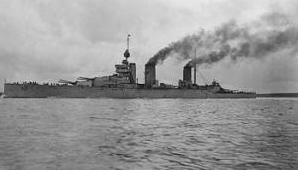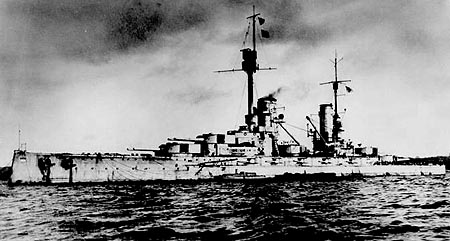|
|
|
|
|
|
|
BATTAGLIA NAVALE DELLO JUTLAND
NAVAL BATTLE OF JUTLAND
|
|
|
|
|
|
|
31 MAGGIO 1916 - 1° GIUGNO 1916


STORIA / HISTORY
PREMESSA / PREMISE
La Hochseeflotte (flotta d'alto mare) tedesca, orgoglio della Germania imperiale, era troppo a lungo rimasta inattiva nelle sue basi nel triangolo di Heligoland e molti tedeschi si chiedevano per quale motivo si erano costruite, a costo di tanti sacrifici, le grandi corazzate, se poi queste rimanevano nei porti.
Nel 1916 aveva assunto il comando della Hochseeflotte l'ammiraglio von Scheer, una creatura del grande ammiraglio Von Tirpiz. Sembrava impossibile che il nuovo comandante , cresciuto all'ombra del "padre" della flotta tedesca, si rassegnasse anch'egli alla solita inattività. Ma l'ammiraglio von Scheer aveva già in mente il suo piano.
Egli intendeva riprendere le sue puntate contro le coste britanniche, ma queste operazioni non dovevano essere fini a sé stesse. Lo scopo era quello di attirare fuori dai "nidi d'aquila" delle Orcadi, di Cromarty Firth, di Rosyth il grosso della flotta inglese, portarla fra banchi di mine e gruppi di sommergibili in agguato ed infine attaccarla. Le mine ed i siluri dovevano ristabilire l'equilibrio (finora tutto a vantaggio dei britannici), prima del decisivo combattimento fra le due flotte di altura. Nel pomeriggio del 30 maggio del 1916 tutti i comandanti germanici vennero chiamati a rapporto sulle rispettive ammiraglie nelle basi attorno a Heligoland. Tornati a bordo i capitani non dissero una sola parola agli incuriositi equipaggi, ma dopo il tramonto, fu ordinato il "posto di combattimento". Alle prime luci dell'alba la flotta tedesca usciva verso il mare aperto: dapprima le squadriglie dei cacciatorpediniere, i cosiddetti "Ussari neri"; poi gli incrociatori leggeri; poi, circondati dalle veloci torpediniere i cinque moderni incrociatori da battaglia dell'ammiraglio Hipper: il Lutzov. Il Deerflinger, il Seydlitz, il Moltke ed il Von der Tan: saranno i primi ad entrare in combattimento, quelli che infliggeranno le maggiori perdite alla flotta britannica dell'ammiraglio Jellicoe.
Ed infine uscirono le sedici corazzate dell'ammiraglio von Scheer , seguite dalle sei vecchie navi della classe "Deutschland", unita molto lente e poco protette che si riveleranno una infida palla al piede nel corso dell'intera battaglia. Nella giornata nebbiosa la flotta germanica procedeva verso nord, lungo le coste dapprima tedesche poi danesi. Mai tante navi germanichesi erano spinte tanto lontano dalle loro basi del Mare del Nord.
Ma nonostante il segreto con cui i tedeschi avevano circondato i loro preparativi, qualcosa era trapelato, così che lo stesso 30 maggio l'Ammiragliato britannico aveva potuto prendere le sue prime contromisure.
Nel lontano 1914 i russi avevano affondato l'incrociatore leggero tedesco Magdeburg e stretto fra le mani di un cadavere avevano trovato un codice di segnali. Intuita l'importanza del ritrovamento, i russi avevano spedito a Londra la preziosa pubblicazione e gli inglesi ne avevano fatto buon uso, riuscendo a decifrare una parte dei messaggi radio nemici. L'Ammiragliato tedesco, nonostante il segreto osservato dai britannici sul ritrovamento, aveva sospettato qualcosa, perché gli incrociatori germanici, nelle loro puntate offensive verso le coste inglesi, trovavano quasi sempre, nei paraggi dell'obiettivo, una forza navale nemica.
Avevano, perciò raddoppiato le precauzioni, cambiando spesso i codici e riducendo al minimo le comunicazioni radio. Ma ormai il servizio informazioni dell'Ammiragliato britannico, era, per così dire, entrato nel sistema nemico e nonostante i cambiamenti riusciva sempre a capire qualcosa.
Così il 30 maggio del 1916 l'Ammiragliato potè informare la Grand Fleet dell'ammiraglio Jellicoe che la flotta nemica stava per prendere il mare. La sera dello stesso giorno la flotta britannica fu concentrata sessanta miglia ad est della costa scozzese, pronta per ogni evenienza.
Mai nella storia due forze navali così poderose si erano trovate l'una di fronte all'altra. Quella britannica però, superava per numero, per velocità e per potenza quella tedesca. Le navi da battaglia dell'ammiraglio Jellico eerano 28 contro le 16 più le 6 vecchie Deutschland) di von Scheer. La velocità delle dreadnoughts inglesi era di 20 nodi per le più lente e di 25 per le più veloci (classe Queen Elizabeth).
Le più veloci corazzate tedesche arrivavano al massimo ai 21 nodi (le 6 Deutschland non arrivavano ai 16). Ai 144 cannoni da 305 ed ai 100 da 230 mm. della flotta tedesca, quella inglese opponeva 48 da 381 mm. (classe Queen Elizabeth), 10 da 355, 142 da 340 e 144 da 305. Una bordata inglese equivaleva a 180.000 chilogrammi di acciaio e di esplosivo lanciati sulle navi nemiche, quella tedesca a 86.500 chili. Gli inglesi erano superiori anche nel campo del naviglio leggero.
The Hochseeflotte (fleet of tall sea) German, pride of imperial Germany, was too for a long time been inactive in its bases in the triangle of Heligoland and many Germans they wondered for what motive you/they were built, at the cost of so many sacrifices, the great battleships, if then these remained in the harbors. In the 1916 assumed avevea the command of the Hochseeflotte the admiral von Scheer, a creature of the great admiral Von Tirpiz.
It seemed impossible that the new commander, grown to the shade of the "father" of the German fleet, he also resigned him to the usual inactivity. But the admiral von Scheer already had in mind his/her plan. He intended to take back his/her episodes against the British coasts, but these operations didn't have to be thin to itself same.
The purpose was that to attract out of the "nests of eagle" of the Orcadis, of Cromarty Firth, of Rosyth the big one of the fleet English, to bring her/it between benches of mines and groups of submersibles in trap and finally to attach her/it. The mines and the torpedos had to reestablish the equilibrium (till now everything to advantage of the British), before the decisive fight among the two fleets of high ground. In the afternoon of 30 May of 1916 all the Germanic commanders were called to relationship on the respective flagships in the bases around Heligoland. Returned on board the captains they didn't tell an only word the incuriositis you equip, but after the sunset, the was orderly "sets of fight." To the first lights of the dawn the German fleet went out toward the open sea: at first the squadrons of the destroyer, the so-called ones "black Hussars"; then the light cruisers; then surrounded by the fast torpedinieres admiral Hipper's five modern battle cruisers,: the Lutzov.
The Deerflinger, the Seydlitz, the Moltke and the Von der Tan: they will be the first ones to enter fight, those that will inflict the most greater losses to admiral Jellicoe's British fleet. And they finally went out the sixteen battleships of the admiral von Scheer, followed from you are her old ships of the class "Deutschland", united very slow and few protected that an untrustworthy ball will be revealed to the foot during the whole battle. In the misty day the Germanic fleet proceeded toward north, along the German coasts at first then Danish. Never so many ships germanichesis were inclined so much away from their bases of the Sea of the North. But despite the secret with which the Germans had surrounded their preparations, something had slipped out, so that the same 30 May the British admiralty had been able to take his/her first countermeasures.
In the distant 1914 the Russian had sunk the German light cruiser Magdeburg and narrow among the hands of a dead body they had found a code of signals. Realized the importance of the recovery, the Russian had sent to London the precious publication and the English you/they had done good use of it, succeeding in deciphering a part of the messages radio hostile.
The German admiralty, despite the secret observed by the British on the recovery, it had suspected something, because the Germanic cruisers, in their offensive episodes toward the coasts English, found almost always, in the parts of the objective, a hostile naval strength. They had, therefore doubled the precautions, often changing the codes and reducing to the least one the radio communications. But by now the service information of the British admiralty, were, for so to say, entered in the hostile system and despite the changes it always succeeded in understanding something.
This way the 30 May of 1916 the admiralty could inform admiral Jellicoe's Grand Fleet that the hostile fleet was about to take the sea. The evening of the same day the British fleet was assembled sixty east miles of the Scottish coast, ready for every eventuality.
Never in the history two so mighty naval strengths were seen the one the other. That British however, it overcame for number, for speed and for power that German. The battle ships of the amiraglio Jellicoeerano 28 against the 16 more the 6 old Deutschland) of von Scheer. The speed of the dreadnoughtses English it was of 20 knots for the more lens and of 25 for the fastest (class Queen Elizabeth). The fastest German battleships reached at the most the 21 knots (the 6 Deutschlands didn't reach the 16). To the 144 guns from 305 and to the 100 from 230 mms. of the German fleet, that English opposed 48 from 381 mms. (class Queen Elizabeth), 10 from 355, 142 from 340 and 144 from 305. A broadside English equivaleva to 180.000 steel kilograms and of explosive launched on the hostile ships, that German to 86.500 kilos. The English were also superior in the field of the light shipping.
LE PIU' GRANDI BATTAGLIE NAVALI (NAVAL BATTLES)
BATTAGLIA NAVALE DELLO JUTLAND / JUTLAND NAVAL BATTLE
PORTAEREI NELLA STORIA (AIRCRAFT CARRIERS)
NAVI DA GUERRA (WARSHIPS AND BATTLESHIPS)